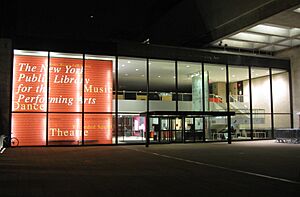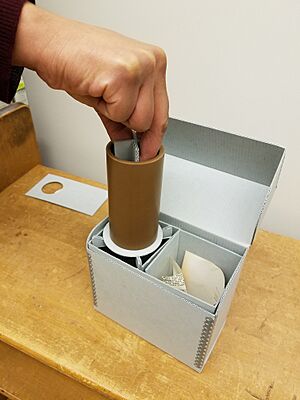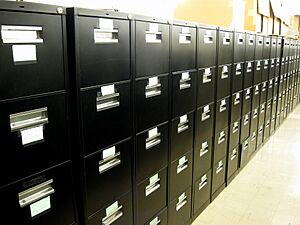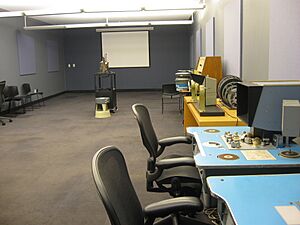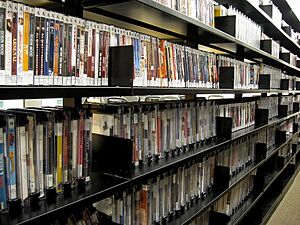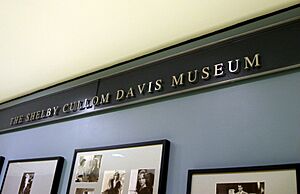New York Public Library for the Performing Arts facts for kids
The New York Public Library for the Performing Arts, Dorothy and Lewis B. Cullman Center, is a special library in New York City. It's part of the famous Lincoln Center complex in Manhattan. This library holds one of the world's largest collections of items about the performing arts. Think of it as a huge treasure chest for music, dance, and theater! It's both a research library, for serious study, and a regular branch library where you can borrow things.
Contents
History of the Library
How the Library Started
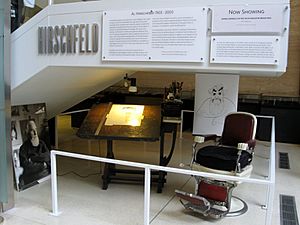
The idea for this special library began a long time ago. In 1932, a person named Carleton Sprague Smith suggested creating a "Music Center for New York." At first, the library's collections were kept in two different buildings. The research materials for dance, music, and theater were at the main New York Public Library building. The music you could borrow was at a different branch.
Over the years, people tried to find a new home for these collections. They even thought about putting them in places like Rockefeller Center or the Museum of Modern Art. The Music Division also held concerts and lectures, often with the Metropolitan Museum of Art and Juilliard School.
Moving to Lincoln Center
In 1956, the idea of a "library and museum of the performing arts" at Lincoln Center came up. Everyone thought it would be a great place to learn about all kinds of performing arts. By 1957, the library was officially going to be part of Lincoln Center.
The building that houses the library and the Vivian Beaumont Theater was the third building to open at Lincoln Center. It was designed by famous architects, including Gordon Bunshaft. The library's research collections opened to the public on July 19, 1965. The whole library opened on November 30, 1965. It was first called the "Library and Museum of the Performing Arts." It even had a museum section named after Shelby Cullom Davis, who gave a lot of money to Lincoln Center.
When it first opened, the library had a bookstore, a place to watch films, and a listening area. There was even a children's performing arts section with a special space for storytelling.
Big Changes in 2001
From 1998 to 2001, the library building closed for a big renovation. This project cost $38 million! During this time, the research materials were moved to a different location. The books you could borrow were also moved.
The library reopened on October 29, 2001. It was given a new name: the Dorothy and Lewis B. Cullman Center. This was to honor the Cullman family, who gave a generous gift.
During the renovation, the library added many computers for visitors. Now, there are nearly 200 public computers. Most of these help you search the library's catalog or watch videos. There's also a special room for learning computer skills.
Before the renovation, each research area had its own reading room. After the renovation, most public reading areas were combined into one big space. However, there are still special rooms for watching films and looking at very rare items. The museum's art display areas were also updated. You can now find the famous caricaturist Al Hirschfeld's desk and chair near the main entrance.
Special Collections for Research
The library has two main parts: a research part and a regular branch part. The research part is funded by private donations. It holds very special and unique items.
What You Can Find Here
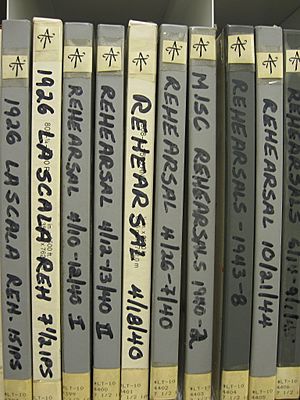
Besides regular books and magazines, the research sections collect many unique things. These include:
- Archival materials: Original papers, letters, and items from people or groups.
- Manuscripts: Handwritten notes for plays, music, or dance.
- Posters and programs: From old shows and events.
- Designs: Original drawings for sets and costumes.
- Sound recordings: From the very first types of recordings to modern ones.
The library has over 500,000 folders filled with newspaper and magazine clippings. These are about different people and topics in the performing arts. They can be a great starting point for research. The library also has about 4.5 million photographs! This includes a huge collection from New York photographer Martha Swope.
Most of these special items are now listed in the library's online catalog. However, some older items might still be found using special card files. Unlike most libraries, you can't just walk into the back rooms to browse these special collections. You need to ask a librarian to get the items for you.
The library's research items are organized into different subject areas.
Music Division
The Music Division is the oldest part of the library. It started with a private collection of music books from a banker named Joseph William Drexel in 1888.
This division has amazing handwritten music, especially for jazz. It includes arrangements by famous musicians like Benny Goodman and Duke Ellington. You can also find original music by classical composers like Bach, Johannes Brahms, and Mozart.
Billy Rose Theatre Division
The library started collecting theater items even before 1931. That year, the family of producer David Belasco offered his collection if a special theater section was created. This section became the Theatre Collection. In 1979, it was renamed the Billy Rose Theatre Division, after a gift from a lyricist and producer. It's now the largest research section. It covers theater, film, vaudeville, magic, puppetry, and circus.
This division includes the Theatre on Film and Tape Archive (TOFT). This archive records live Broadway and Off-Broadway plays. You can watch these recordings in a special screening room. It's one of the biggest collections of videotaped plays in the world! They record about 50 to 60 live shows each year.
Jerome Robbins Dance Division
The Dance Division started in 1944. At first, dance materials were part of the Music Division. But the collection grew so much that it became its own division in 1964.
A very important part of this division is the Jerome Robbins Archive of the Recorded Moving Image. This archive collects and saves videos of dance performances. It has many private films and videos given by dancers and choreographers. The division also has an "oral history" program. This means they record interviews with dancers and choreographers. These interviews share stories and information you can't find in books.
Rodgers and Hammerstein Archives of Recorded Sound
This archive started in 1937 with a gift of 500 old 78-rpm records. More gifts from record companies and people led to it becoming a separate division in 1965. It was named after the famous musical creators Rodgers and Hammerstein, who made a donation. This archive has a huge collection of old 78 rpm records.
Reserve Film and Video
This collection is for films and videos that must be watched at the library. It has a screening room big enough for classes. It also has special equipment like moviolas and Steenbecks. These allow you to watch films frame by frame for detailed study.
Borrowing Collections
The library also has a regular part where you can borrow items. This part started in 1920 with a collection of 1,000 books and music scores.
In 1929, they started collecting recordings. They even had a listening booth that was always booked! During World War II, the library held concerts for servicemen. They could request music or even play chamber music with instruments loaned by the library.
Today, the borrowing collections let you check out books about music, dance, theater, and film. You can also borrow music scores, scripts, CDs, videotapes, and DVDs. They even have an Orchestra Collection, which loans out music parts for groups to perform.
Museum Exhibitions
The library has museum spaces with exhibitions. These are in two main galleries and other display cases around the building. The goal of these exhibitions is to show everyone that the library's millions of items are not just for scholars. They are for anyone who visits! The exhibitions highlight items from the library's collections and help attract new donations.
Since the late 1990s, the library has also created online exhibitions. These are like virtual tours that let you explore more materials in depth.
Free Public Programs
The library offers free public programs in its 202-seat Bruno Walter Auditorium. This auditorium is used several times a week for:
- Musical performances
- Film screenings
- Lectures
See also
- List of New York Public Library branches


